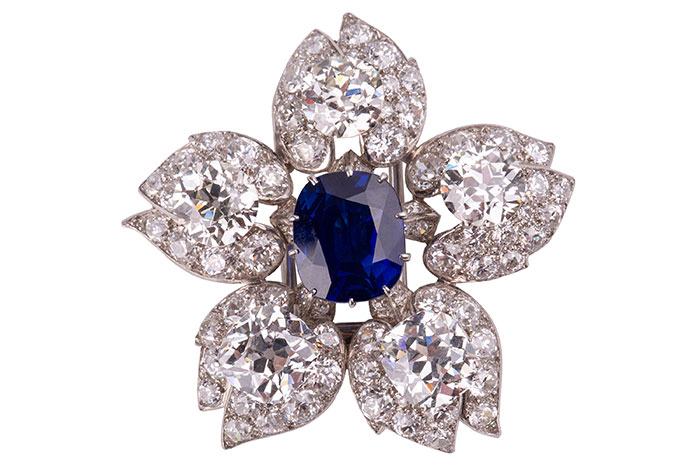What Colour Sapphire is Most Valuable?
These beautiful gems actually come in a wide range of colours
19/07/2024
As one of the world's top three most valuable gemstones, sapphires are admired for their stunning beauty and enduring durability. While many of us associate sapphires with a classic royal blue hue, sapphire is a variety of the mineral species corundum, where red corundum is known as ruby. All the other coloured corundum is defined as sapphires, and those not blue are collectively known as “fancy sapphires”. Different trace elements in the chemical makeup can cause different colours ranging from orange, pink, violet, yellow, purple and green; or lack of, resulting in colourless or white.
An Art Deco sapphire and diamond set bar brooch
But in terms of value, not all sapphire colours are equal. After the incredibly rare orangey-pink coloured padparadscha sapphire, the classic blue variety is historically the most popular and desirable sapphire colour. Below are some of the factors that would affect a blue sapphire’s value:
Colour - Hue, Saturation, Tone
Colour is the most important element in estimating the value, according to the GIA colour gemstone grading system, colours can be broken down into hue, saturation and tone.
- Hue reflects the colours we see. When most people discuss "colour," they're actually referring to hue. Since sapphires are dichroic, which sometimes affect the body colour when viewed from different directions. The secondary colour is listed first, and the primary colour is listed after. Therefore, a greenish-blue hue indicates that blue is the primary colour, and greenish is the secondary colour, meaning it's mostly blue with a greenish tint. For a sapphire to be called “blue,” its secondary colours (e.g. green or purple) must not account for more than 15% of its colour. Blue is ideal.
- Saturation refers to the hue's intensity. It is the extent to which the hue is masked by brown or grey, where it loses saturation. In other words, a strongly saturated stone will have a colour equal to the pure hue, whereas a weakly saturated gem will change colour to grey.
Vivid is ideal. - Tone refers to a gem's relative lightness or darkness. While two sapphires may have the same hue, they can have differing tones. Dark sapphires are abundant and never reach very high values.
A medium tone is ideal.
Parti-coloured (colour zoning)/ evenness of the colour
Traditionally the most sought-after sapphires will have a uniform body of colour, heat and diffusion treatments are even used to enhance and even out the concentrated colour. However, there is a growing market for particoloured sapphires due to fashion and trends, which are sapphires that feature two or more distinct colour zones within a single stone and would be very difficult to find two of the same. The most common bi-colour combination is yellow and green. Rarer stones that multi-colour combinations are especially prized.
Colour-changing properties
Traces of vanadium may cause colour change in some sapphires. These sapphires show one colour in fluorescent light and subtly or dramatically change into another colour under incandescent light. Most colour-change sapphires come from Sri Lanka and Tanzania, with new material being produced recently in Madagascar as well. For these stones, clarity is far less important than the degree of the colour change.
The following elements also affect the value of a sapphire:
Treatment: Heat treatment in corundum is accepted as a common practice. They will heat treat the sapphire to darken it and improve colour distribution. In contrast, the value of a sapphire would increase dramatically when it has had any treatments and enhancements, and that’s why finding evidence of these procedures can be critical.
Inclusions: Silk inclusions are acceptable in blue sapphires, as long as they are not so dense that they compromise the colour. In fact, silk inclusions can increase the value of a stone by giving it a velvety look like the prized Kashmir sapphires. They scatter light and give the stone a soft, velvety appearance. It creates a glow that, at the same time, minimizes dead spots (extinction). It could also produce the optical phenomenon ‘asterism’ when faceted into cabochons needed for star sapphires.
A spectacular Cartier Kashmir sapphire and diamond flower brooch, circa 1930s
Conclusion
Within the blue sapphires, the most valuable examples are typically those with a rich intense blue colour. Kashmir sapphires that display a “royal blue”, and Ceylon sapphires with a “cornflower blue” hue are the most sought-after colours. Untreated sapphires with these pure, intense blue tones are the rarest and most expensive within the blue variety.
In contrast, sapphires in darker or lighter blue, green, yellow, or purple tones are generally less valuable. These fancy sapphire colours are still beautiful, but they are more common and therefore less expensive than the premium blue and pink-orange varieties.
Unsure as the value of your sapphire jewellery? We would always recommend consulting with a specialist. Led by Gemmologically qualified expert jewellery Valuers, here at Dawsons, our friendly team provide confidential valuation and sales advice, whilst providing the highest standards of assessment and authenticity. With in-house testing equipment for gemstones, every piece undergoes rigorous scrutiny, meaning that we can provide an accurate and current market valuation.
Read more
Is a Sapphire Ring Worth Anything?
How Rare is a Kashmir Sapphire?
How Do I Sell Unwanted Jewellery?

Nicky Houston
Our Head of Jewellery, Watches & Silver... Nicky is a highly respected Auctioneer & Valuer, who had dreams of becoming an artist. Whilst she may not have made it as a successful artist herself, Nicky has helped many a customer to successfully sell and buy beautiful pieces of jewellery and works of art over her many years working within the auction industry.
Jewellery Silver & Objects of Virtue Watches
Are you thinking of selling any sapphire jewellery?
With a global audience of over 10 million active bidders, Dawsons can secure the best prices for you.
Get in touch with an expert Valuer for confidential sales advice, we would be delighted to help:


